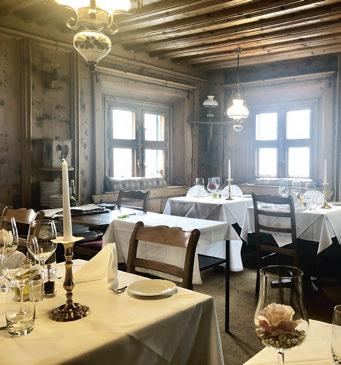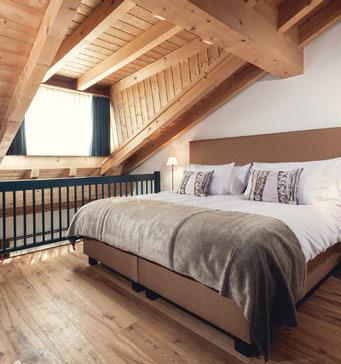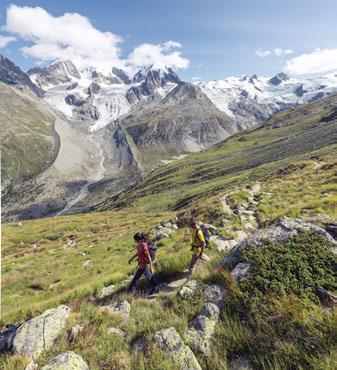
12 minute read
STÜVA
GIAN RETO RAINALTER, THE ARCHITECT WHO RENOVATED THE HOUSE CONTAINING THE PICTURED STÜVA.
Advertisement
Heart of the home
The oriel windows in Engadin stüvas allow a sweeping view of life outside.

Tradition: The heart of the traditional Engadin home or farmhouse is known as the “stüva” in Romansh: a panelled room where the family would gather and relax. This was the warmest and cosiest room in the house, with a stove that was heated via the neighbouring “chadafö” – the kitchen. The stüva’s low ceiling, the small windows and the insulating layer between floors, filled with earth, all helped retain heat. To this day, stüvas – whether decorated with traditional wood carving,
or simple and modern in style – are still highly popular, especially because of their cosy atmosphere. This was not always the case: when oil paint came into fashion for decoration, farmers would paint over the wood to make the stüva appear more modern and create an impression of affluence. They probably also wanted to give the room a fresher feel: the stüvas often smelt of wet farm clothing, which members of the family would dry by the stove here. Over recent years, residents have increas ingly preferred a natural wood finish, removing any existing colour – although patches can sometimes still be seen in knotholes.
Wood: For panelling, ceilings and furniture in Engadin stüvas, joiners mostly use Swiss stone pine, primarily because the timber is soft and easy to carve. The wood also smells wonderful and – it is claimed – helps maintain a pleasant air quality and makes for a peaceful night’s sleep. The essential oils in Swiss stone pine repel flies in summer; in winter, the wood stores warmth. However, Swiss stone pine is unsuitable for construction of the house itself, because of its low load-bearing strength. As a result, stüva floors are usually made of planks of larch, pine or spruce.
Furnishings: A traditional Engadin panelled stüva has the following furnishings: a stove, a fitted sideboard, a bench running along the walls, a slate-top table with chairs, and a corner shelf with bible. Visitors who look closely will see a narrow staircase concealed behind the oven, leading via a hatch to the bedchamber above.
On the fourth stage of the Via Engiadina from Bever to Zuoz.

Da stüva a stüva
The Via Engiadina leads through forests, across rivers and over alpine pastures – and from one welcoming wood-panelled stüva to the next.
2,400
2,200
2,000
1,800
1,600
1,400 STAGE 1
Stage 1 – Maloja to Silvaplana
The Fedecla river tumbles past the Hotel Maria in Sils on its way to Lake Silvaplana. By now, hikers have completed half of the first stage of the Via Engiadina. They have already passed through the idyl- lic hamlet of Grevasalvas, where “Heidi” was once filmed; soon, they will continue along the Engadin’s chain of sparkling lakes. A stop in Sils requires leaving the route at Sils Föglias to drop down into the village. As soon as walkers cross the doorstep of the Hotel Maria, they feel the warm cosiness of Swiss stone pine. The Stüva Marmoré was a grocery shop in the 1930s; later, the Sils Curling Club was founded here. Today, the black soapstone stove serves only as decoration, but it is easy to imagine the scent of burning wood, which once heated many such stüvas. The house speciality here is Cordon bleu: a de- licious and hearty dish, perfect for a long walk, with the advantage that calories are quickly burnt off along the way. Blaunca 2,039 m Grevasalvas barbecue picnic site Plaz bench Sils Föglias, descent to the Hotel Maria Fratta
1km 3km 5km 7km 9km 11km
At the end of the first stage, tired legs will appreciate a little relaxation – and they are sure to find it at Conrad’s Mountain Lodge in Silvaplana. When the Conrad family bought the building in 1952, it was just an annex to another hotel. But even the Hotel Conrad that they created cannot be compared to today’s venue. In summer 2018, the lodge was completely refurbished, and reopened with Cindy Conrad at the helm. Since then, wood and stone have dominated the interiors, linking the wild mountain scenery with modern design. Local larch, for example, has found a new home in the form of panelling on the walls, sauna fittings and bed frames.
Stage 2 – Silvaplana to Celerina
Although the Trutz mountain restaurant by the top station of the Suvretta–Randolins chairlift is no typical stüva, it provides an unmissable stop along the Via Engiadina. The views over the lakestrewn Engadin valley could not be better, from sun terrace and dining room alike. The restaurant belongs to Suvretta House, a venerable hotel with a history dating back more than 100 years. Highlights here include the nourishing barley soup, tasty Polenta and sweet Kaiserschmarren pancakes; add the glorious views, and any hiker will be tempted to linger. But there is still some way to go until the end of the second stage in Celerina, with a couple of hundred vertical metres to climb en route: no problem after the relaxing and energising lunch.
STAGE 2
Silvaplana
START:
In the theatrical setting of the Hotel Arturo in Celerina, it is wood that plays the starring role. At the end of a day’s hike, guests happily take a seat in the panelled “Stüva da Dschember” to m Suvretta alpine pasture Trutz mountain restaurant Quattro Bar Lej Alv, 2,558
1km 3km 5km 7km 9km 11km Lej Alv natural reservoir
13km Marguns
FINISH:
14.7km


First stop: the Stüva Marmoré at the Hotel Maria in Sils.
Superb vantage point: the Trutz mountain restaurant by the top of the Suvretta–Randolins chairlift.

Fine food and a good night’s sleep: the Hotel Arturo in Celerina (left) and Conrad’s Mountain Lodge in Silvaplana.

savour gastronomic delights in a uniquely cosy atmosphere. Those who enjoy an after-dinner cigar or digestif can relax in “La stüva per fümer” before a peaceful night’s sleep in one of the bedrooms full of rustic charm. The following day starts early: the next stage is long. In the breakfast room, a generous buffet offers a variety of tempting treats, while guests enjoy the soothing aroma of Swiss stone pine one last time before setting off on the day’s hike.
Stage 3 – Celerina to Bever
The Chesa Salis acquired its name and current appearance from the von Salis family, long regarded as one of the most important in the Engadin and the Val Bregaglia. Originally built in 1590 as a farmhouse, the structure was converted into a magnificent aristo- cratic residence 290 years later. The three-storey wooden veranda on the southern side of the house and the ornate decorations on the facade give the Chesa Salis the aura of a palazzo. In 1981 it opened its doors to guests as a hotel, offering 18 delightful rooms with stucco decoration and traditional wood panelling. This is a homefrom-home unlike any other: a place to charm the soul.
STAGE 3
Marguns START:
1km V al Zuondra m Munt de la Bês-cha, 2,490
3km Muntatsch, Clavadatsch
5km Muntatsch alpine pasture Muntatsch, Clavadatsch Muntarütsch Bever
FINISH:
7km 9km 9.9km

View of La Punt Chamues-ch: along the fourth stage from Bever to Zuoz

Stylish palazzo: the Chesa Salis in Bever.

A night’s sleep framed by wood: the Hotel Krone in La Punt.

Stage 4 – Bever to Zuoz
The Via Engiadina does not actually pass through La Punt, but the village is well worth a detour – even an overnight stop. At the Hotel Krone, Sonja and Andreas Martin having been working their magic for more than 18 years. While Sonja takes care of guests, Andreas conjures exquisite fare in the kitchen – including dishes featuring Swiss stone pine. He stumbled on the idea about seven years ago during a walk, when he picked up a couple of pine cones and took them back to the hotel. He now uses nearly all parts of the tree. He steeps the cones in alcohol to make flavoured spirits; ferments the bark with vegetables; smokes fish and lamb fillets with wood shavings; and uses pine needle tips in fritters. The challenge is finding balance: the tree is full of essential oils, and the flavour intense. Each dish is also a feast for the eyes – as are the hotel’s interiors. The job of extending and refurbishing the hotel went to the architects Ruch & Partners, who used different kinds of solid local timber – such as Swiss stone pine, larch and maple – to create an architectural work of art.
2,000
1,800
1,600
1,400 STAGE 4
Bever
START:
God da Plaz God Arvins, God Drosa
Hearty fare in a cosy stüva: at the Hotel Veduta in Cinuos-chel.

Wood from floor to ceiling: at the Dorta in Zuoz.
STAGE 4
Acla Albertini Arschaida bench Plaun Grand Plaun dalla Bes-cha 1,991 m Bos-chetta Bach barbecue picnic site Purtum bench Zuoz
START: / FINISH
STAGE 5

The fourth stage ends in Zuoz, a village that could easily have met its own end long ago: in 1499 the entire settlement went up in flames. Zuoz was completely rebuilt, however, including the Dorta. After Gian Rico Blumenthal bought the venue nearly 30 years ago, he breathed new life into it. The former pizzeria became a restaurant known for dishes inspired by cuisine from Graubünden and the Valtellina, while the barn made a wonderfully cosy dining room, imaginatively decorated with Rico’s hunting accessories and agricultural implements. Every corner has a story to tell. Brave guests can climb a ladder to reach the stüva with the lowest ceiling of all; happily, diners have to duck only when standing up.
Stage 5 – Zuoz to Zernez
The Veduta hotel and restaurant in Cinuos-chel is not quite on the route of the fifth stage, but is also worth a detour. In Gudench and Sabrina Campell’s stüva, the scent of local wood blends with the aroma of delicacies such as Capuns (dumplings wrapped in chard) and Graubünden barley soup. Gudench, a keen hunter, serves game in autumn, and enjoys telling diners the inside story of their meal. Hikers not only stock up on energy for the final few kilometres, they also pick up conversation material and know-how that could help them spot deer near the Swiss National Park – or at least, in autumn, hear the stags’ dramatic belling echo through the valleys.
descent to the Veduta in Cinuos-chel God Murter God da Brail Brail alpine pasture
Along the Via Engiadina
Hikers can select and book accommodation for the journey themselves – or let the travel company Eurotrek organise everything. The specialist operator will also arrange luggage transport. engadin.ch/en/via-engiadina
An extra dimension
The Via Engiadina continues beyond the Upper Engadin for another 60 kilometres into the Lower Engadin, as far as Tschlin. maps.engadin.ch
Even more stüvas
Visitors can explore the fascinating history of the stüva at the Museum Engiadinais in St.Moritz. The heart of the museum is a series of panelled rooms up to 500 years old from throughout the region, painstakingly restored. museum-engiadinais.ch
Via Engiadina
All routes and deals for the Upper Engadin: engadin.ch/via-engiadina
God Muntatsch-Ertas Vallanzun
Hiking heaven
Key steps to mountain adventure
1 2 3
5 4

Head to foot
Mammut products promise many days of hiking pleasure in the mountains – and ensure that users are prepared for the unexpected, too. mammut.com
1 Lovely legs *
The “Runbold Light” women’s trousers are ideal for hot summer days thanks to their light and stretchable material. They are also water-repellent, in case it unexpectedly starts to rain.
2 Slick backpack !
The “Ducan 24” backpack is light and fitted with an air space suspension system, ensuring good ventilation of the back area for comfort.
3 Sleep well!
The “Relax Down” sleeping bag promises a quieter night’s sleep thanks to special fabric in the head section.
4 All-weather jacket *
The “Convey Tour HS Hooded” jacket provides protection from wind and rain and also keeps the wearer dry inside thanks to breathable materials.
5 Fine footwear*
The “Sapuen High Gore-Tex®” boot is waterproof, adapts to the shape of the foot and optimises its natural rolling movement, improving energy efficiency and boosting hiking pleasure.
*available from summer 2021
580
kilometres of trail form an unrivalled network in the Upper Engadin, with nearly 100 itineraries from easy to difficult. engadin.ch/hiking

4,049m
The Piz Bernina (4,049m) is the highest mountain in the Eastern Alps.
Ride up high
The Muottas Muragl funicular was Graubünden’s first mountain railway built to carry tourists.
Tour of the giants
Bernina massif –In addition to the Via Engiadina, a second long-distance hike leads through the Engadin mountains: the Bernina Tour. This spectacular itinerary, with 7,500 vertical metres of altitude difference and a total distance of 75 kilometres, leads around the Bernina massif in five stages. Starting in Poschiavo, hikers head up to the Bernina Pass before crossing over the Fuorcla Surlej to reach Maloja. An undeniable highlight of the whole tour is a night at the Berghaus Diavolezza moun- tain hotel with views of the Morteratsch Glacier. engadin.ch/bernina-tour-hike
Sleep up on high
The Chamanna Georgy (3,175m) is the highest mountain hut in the Engadin.
i
Other long-distance hiking trails
Via Valtellina
This muleteers’ route leads in seven stages from the Valtellina to the Montafon valley via the Engadin.
Via Albula/Bernina
Along the Rhaetian Railway’s World Heritage lines from Tirano to Thusis. engadin.ch/long-distance-trails
A gastronomic hike in three courses The Via Gastronomica offers a scenic hike with a difference: along the way, three different restaurants provide welcoming stops for starter (or breakfast), main course and dessert. The walk itself takes 2–3 hours; hikers can choose their own route. engadin.ch/en/via-gastronomica







